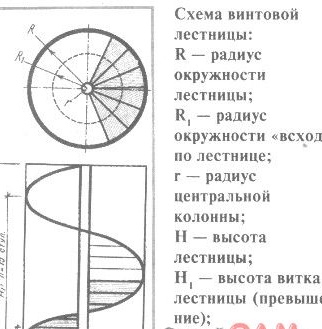
A spiral staircase is usually used for internal communication between rooms located on different floors. Spiral staircases are made where you have to save the amount of living space. The width of marches for a spiral staircase is more rational to take no more than 0.95 m.
Calculation of a spiral staircase is as follows. Suppose you want to design a spiral staircase with a width of S = 0.8 m and a height of H = 3 m. First, we determine the total diameter of the spiral staircase D, which is equal to the sum of the double width of the flights and the thickness (diameter) of the central support column. For example, if the supporting wooden column has a thickness of = 0.2 m, then the diameter of the spiral staircase is D = 2xS + b = 2xO, 8 + 0.2 = 1.8 m.
From the center of the stairs (Fig.), We describe a circle with a radius of R = D: 2 = 0.9 m and draw a central column with a radius of r = 0.1 m into it. Then, with a radius of R1S: 2 + r = O, 8: 2 + 0.1 = 0.5 m describe a circle that represents the projection of the shoot line on the plan of a spiral staircase. To determine the number of steps n per one turn of the ladder, we divide the circumference into parts equal to the desired width (depth) of the step s along the shoot line. For example, take the step width along the shoot line s = 0.2 m. Then the number of steps is n = 2xPR1: s = 2x3,14x0.5: 0.2 = 15.
Divide the circle into n parts (in this case, 15) and draw radial lines.
So that when climbing up and down the spiral staircase, a person moves freely, without hitting his head on the inner side of the steps, it is necessary to exceed H1 of the 15th step over the 1st, corresponding to the growth of the average person or even more. For example, let’s take a person’s height to be 1.9 m. In addition, “growth” (0.2 m) and step thickness (0.05 m) will have to be added to this growth, if steps are made from a “fifty” board. Thus, the excess of the 15th step over the 1st will be equal to the sum of the person’s growth, “stock” and the thickness of the step. That is, H1 = 1.9 + 0.2 + 0.05 = 2.15 m.
Dividing the height of the full turn by the number of steps (n = 15), we obtain the height of one step h = H1: n = 2.15: 15 = 0.14 m.
The total number of steps of a spiral staircase is determined by dividing the entire height of the stairs by the height of one step. In the case under consideration, at H = 3 m, the total number of steps is n = 21, and the number of treads, respectively, is n –1 = 21–1 = 20.
The insufficient tread width in the spiral staircase can be compensated by the overhang at the steps. The “protrusion” of the overhang of a step shall not exceed 0.09 m.
For the convenience of climbing a spiral staircase, the diameter of the middle column is usually increased, as a result of the step, a trapezoidal shape is obtained, while the width of the step of the inner end increases.
The direction of entry and exit from the stairs in this case (with n = 21) will not coincide.
